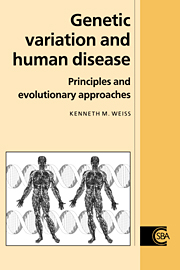Book contents
- Frontmatter
- Contents
- Frontispiece
- Preface: what is this book all about?
- Notational conventions used in this book
- List of abbreviations
- Part I Genes and their expression
- Part II Introduction to genetic epidemiology: inference from observational data
- 5 Segregation analysis: discrete traits in families
- 6 Segregation analysis: quantitative traits in families
- 7 Linkage analysis: finding and mapping genes for qualitative traits
- 8 Linkage analysis: finding and mapping genes for quantitative traits
- Part III Evolution: the time dimension in populations
- Part IV Modification of the inherited genotype: the time dimension in individuals
- Afterwords: towards a unified general model
- References
- Index
5 - Segregation analysis: discrete traits in families
from Part II - Introduction to genetic epidemiology: inference from observational data
Published online by Cambridge University Press: 05 June 2012
- Frontmatter
- Contents
- Frontispiece
- Preface: what is this book all about?
- Notational conventions used in this book
- List of abbreviations
- Part I Genes and their expression
- Part II Introduction to genetic epidemiology: inference from observational data
- 5 Segregation analysis: discrete traits in families
- 6 Segregation analysis: quantitative traits in families
- 7 Linkage analysis: finding and mapping genes for qualitative traits
- 8 Linkage analysis: finding and mapping genes for quantitative traits
- Part III Evolution: the time dimension in populations
- Part IV Modification of the inherited genotype: the time dimension in individuals
- Afterwords: towards a unified general model
- References
- Index
Summary
And so do his sisters, and his cousins and his aunts!
W. S. Gilbert, H.M.S. Pinafore (1878)We can understand the basic principles of genetic epidemiology by studying the behavior of alleles at a single locus in nuclear families. We take advantage of evolution-based constraints on the distribution of genetic variation in families. The analysis of trait distributions in families is known as segregation analysis after Gregor Mendel's Law of Segregation of individual alleles at a locus. The idea is to see if the pattern of phenotypes in families is consistent with a genetic model.
Families are ascertained via one or more index individuals, or probands (propositi), who may be either randomly identified, or chosen because of their disease or other phenotype status. The nature of the sampling must be built into the genetic model. This chapter illustrates the principles of segregation analysis by the study of genotypes that are strongly associated with categorical phenotypes {Cavalli-Sforza and Bodmer, 1971; Elandt-Johnson, 1971; Levitan, 1988; Li, 1961; Morton, 1982; Thompson and Thompson, 1986; Vogel and Motulsky, 1986}.
Appendix 5.1 provides some basic probability theorems for those who need them.
Nuclear families and sibships
The distribution of traits in families
A diploid, sexually reproducing organism has two sets of genes, one inherited from each parent. Each time that individual produces his/her own gamete (sperm or egg), one of his/her inherited alleles, at each locus, will be randomly chosen and transmitted in the gamete. There is thus a probability of ½ that an offspring will inherit a specific parental allele.
- Type
- Chapter
- Information
- Genetic Variation and Human DiseasePrinciples and Evolutionary Approaches, pp. 69 - 91Publisher: Cambridge University PressPrint publication year: 1993
- 1
- Cited by



